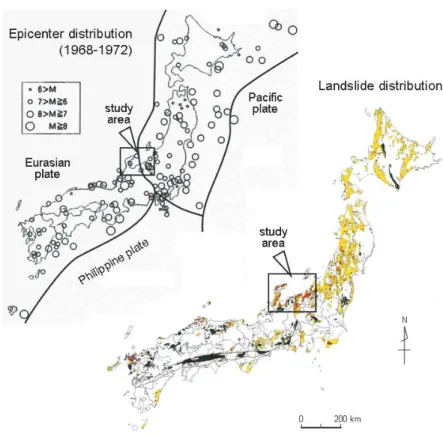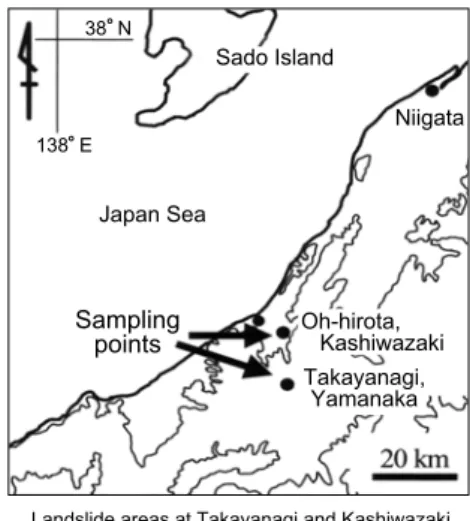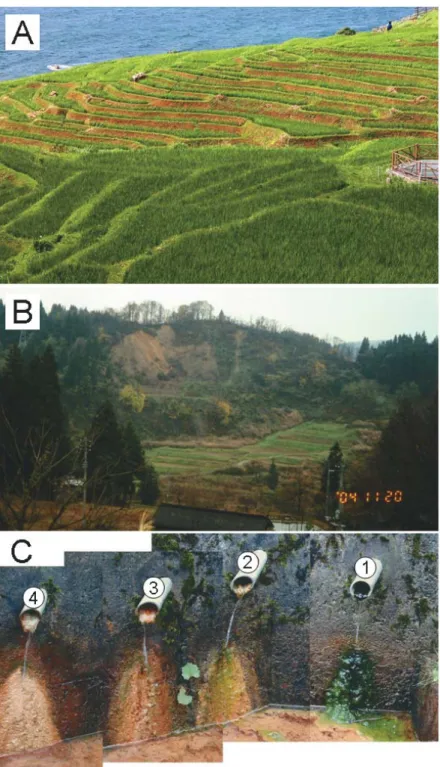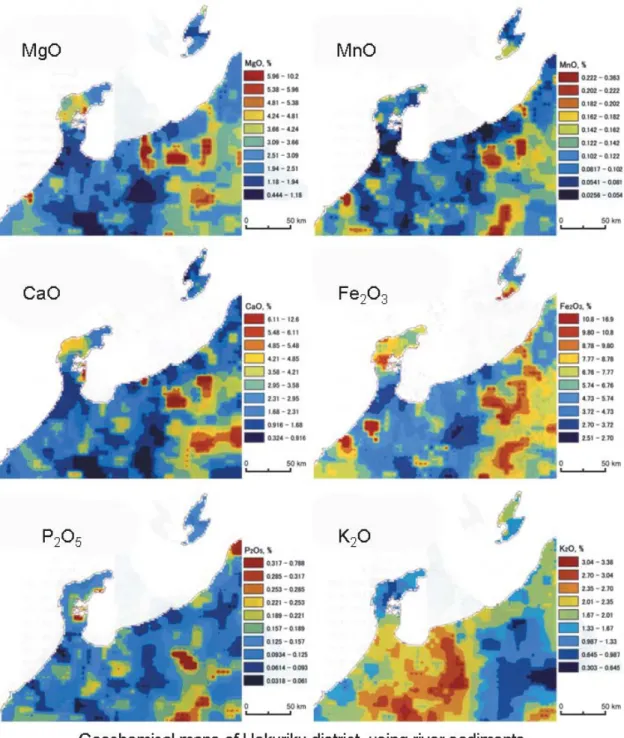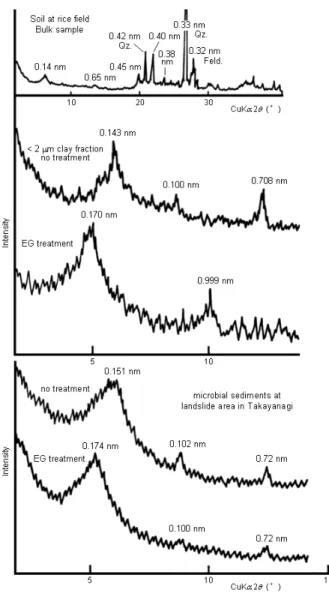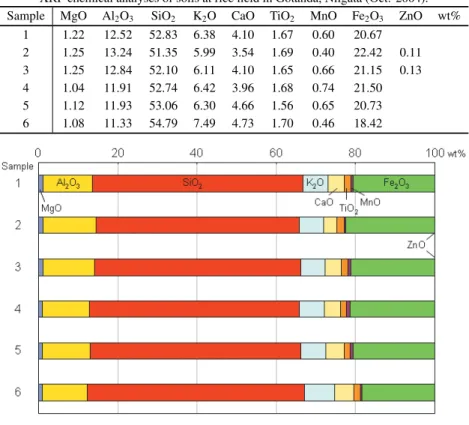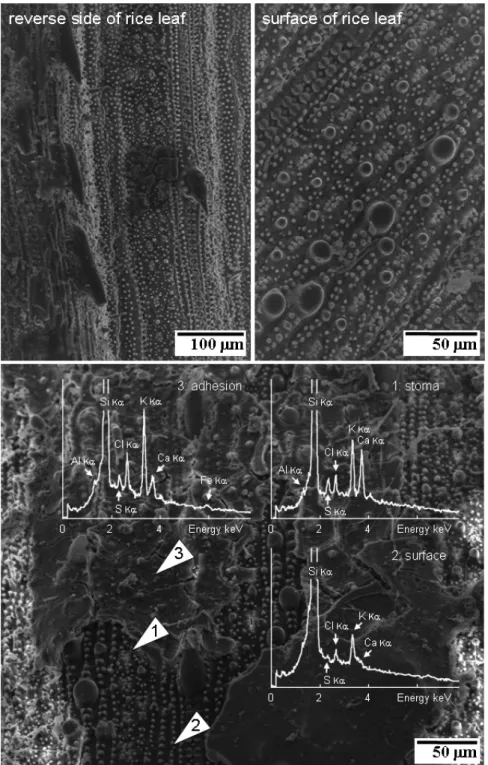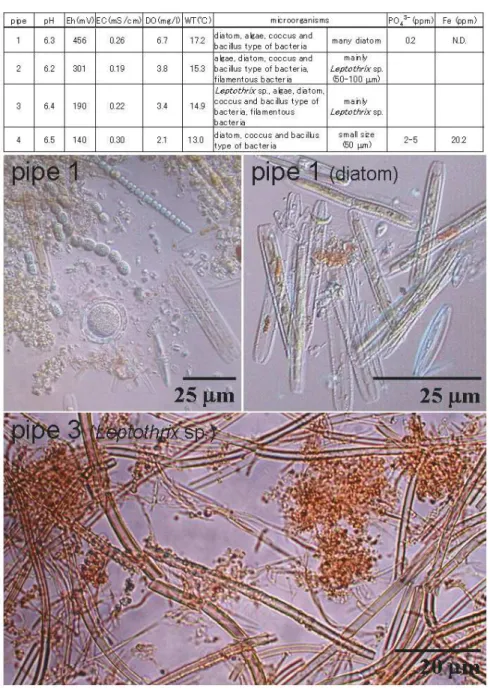www.scielo.br/aabc
Green-tuff landslide areas are beneficial for rice nutrition in Japan
KAZUE TAZAKI
Department of Earth Sciences, Faculty of Science, Kanazawa University Kakuma, Kanazawa, Ishikawa 920-1192 Japan
Manuscript received on September 29, 2005; accepted for publication on March 13, 2006;
presented byOTHONH. LEONARDOS
ABSTRACT
Japanese Islands are covered with weathered volcanic rocks and soils. Terraced rice field are located in green-tuff areas which are very fertile but where landslides occur associated to strong earthquakes. The X-ray diffraction and X-X-ray fluorescence analyses of the soils in landslide area identified predominant smectite and Mg, Al, Si, K, Ti, Mn and Fe are main components. The rice leaf showed that S, Cl, K and Ca play important roles for nutrients in the area. Drainpipe systems have set up in the green- tuff areas to reduce the risks of landslides. Reddish brown microbial mats inhabited bacteria and diatom in the drainpipe outlets. The microbial mats are rich in Fe and PO3−
4 . The iron bacteria in the ground water have a high metabolic rate suggesting that the weathering materials were produced by not only physical and chemical influence but also by microorganism. Many microorganisms attach to mineral surfaces and show their high impact in the water mineral chemistry in the landslide area. Bacteria in the green-tuff over landslide area play important roles for sustainable agriculture including rice nutrition.
Key words:green-tuff, terraced rice field, landslide, microbial materials.
INTRODUCTION
Volcanic rocks are predominant in Japanese Is-lands. Weathered volcanic rocks cover mostly the surface of the Japanese Islands. Terraced rice field are commonly located over volcanic ashes, pumice and green-tuffs. The alteration of those rocks gener-ates fertile soils. Otherwise, this area is tectonic ac-tive and tragic landslide accidents caused by strong earthquakes (Shoji et al. 1993; Fig. 1) occurred. Earthquakes (up to 7 a magnitude of 7) occurred in Niigata at the Japan Sea Coast, on 25thOctober, 2004. In this area, green-tuff formation occurs and a famous agricultural district which produces high quality rice is situated. In this mountainous Japanese Country, in flat land, rural houses and rice field are
E-mail: kazuet@kenroku.kanazawa-u.ac.jp
often built under steep slop.
Fig. 1 – Earth quakes in tectonic active areas and landslide distribution in Japanese Island. Arrows indicate study areas.
where the soils are poor and subsistence agriculture has been practiced for a long period of time, many of these nutrients are simply no long in the soils.
Geochemical map of Japan (Geological Survey of Japan 2004), using river sediments, provides us with valuable information on agricultural research conducted with some of the minerals and rocks locally available in Hokuriku district in Japan (Fig. 4). The maps with its extensive and up-to-date references are an excellent starting point for inte-grated agricultural research and development work in Japan, for soil scientists, geoscientists, and engi-neers. The concept of agrogeology certainly needs more recognition and we must do more to foster trans-disciplinary research and development to tackle our environmental problems and address is-sues of food security. Soil remediation is critical to the global problem of food security. We must use
the right “rocks” on the right “crops”.
In this study, I propose new approaches for soil remediation using microbes in the drainpipe outlets over the landslide area, not just the use of chemical fertilizers. Takayanagi in Niigata prefec-ture is a typical landslide area for microbial study, where the drainage systems were established to pre-vent mudslide occurrence. SEM-EDX observations revealed the diversity of ecosystem, which depends on the characteristics of water and soils with useful elements for the right crops.
MATERIALS AND METHODS
The samples of river sediments, soils and rice leaf around landslide area, and microbial mats of drain-pipes were collected from Takayanagi in Niigata prefecture, Japan. Water drainage system (through the pipe) was established in the landslide areas of Takayanagi and Oh-hirota in Kashiwazaki, Niigata (H. Segawa et al., unpublished data) (Fig. 2). The numerous drainpipes were set up in the locality to inhibit mudslide occurrence (Fig. 3A, B). Each drainpipe carried groundwater all the time result-ing the formation of microbial mats in the outlet of the pipes (Fig. 3C). Different colored microbial mats with ground waters were collected from those drainpipe outlets for analysis. The drainpipes, 50 m in length, were radially set up for drained ground-water off. The microbial mats are light reddish brown (point 1), reddish brown (point 2), greenish brown (point 3), and green microbial mats (point 4) in color, respectively.
The pH, Eh, DO (Dissolved Oxygen), and water temperature were measured in the field us-ing a HORIBA portable inspection meter. Micro-bial mats were examined with a polarizing optical and fluorescence microscope (Nikon OPTIPHOT-2 EFD3). The sample stained with 4’, 6-diamidino-2-phenylindole (DAPI) is observed through an episcopic fluorescence microscope. DAPI method stains the DNA in bacterial cells, and blue fluo-rescence under ultraviolet light (365 nm) indicates metabolically active bacteria.
A low-vacuum scanning electron microscope
Sado Island
Japan Sea
Sampling points 38 N
138 E
Niigata
Takayanagi, Yamanaka Oh-hirota,
Kashiwazaki
Landslide areas at Takayanagi and Kashiwazaki in Niigata Prefecture.
Fig. 2 – Locality map of landslide areas shows sampling points at Takayanagi and Kashiwazaki in Niigata prefecture in Japan.
(LV-SEM, JEOL JSM-5200LV) equipped with an energy dispersive X-ray spectrometer (Philips EDAX PV9800EX) (SEM-EDX) was used to ob-serve the micro morphology of rice leaf, and its chemical composition. The samples were mounted on stubs using carbon tape and examined at accel-erating voltages of 15–25 kV. Mineralogical invest-igations of river sediments and microbial mats were performed by X-ray powder diffraction (XRD). A Rigaku Rinto 1200 X-ray diffractometer (CuKα
radiation) operating at 40 kV and 30 mA, and a scanning speed of 1–20 sec. / 0.02 degree, was used. Chemical composition of the samples was ana-lyzed using the energy-dispersive X-ray fluorescen-ce (ED-XRF) analyzer (JEOL JSX 3201) applying Rh radiation at 30 kV. The chemical composition of microbial mats was determined and the quantity of PO3−
4 was made using an automatic gas
chro-matography.
LANDSLIDESITES ANDEPICENTER
DISTRIBUTION INJAPAN
Most earthquakes are located in tectonically active areas and volcanic activity is a process generally related to plate tectonics. Most volcanoes are lo-cated at plate junctions where magma is produced as spreading or sinking lithospheric plates interact with other earth materials. The occurrence of land-slides is closely related to the geological conditions. Depending on the geological features, landslides are largely classified into 3 categories, i.e. (1) Ter-tiary system landslide, (2) Fracture zone landslide, and (3) Hydrothermal zone landslides. Tertiary sys-tem landslide occurs in Hokuriku district, associ-ated with soft rock prone to rapid weathering, but the movement tends to be slow (Koide 1955). Ter-tiary system landslide commonly occurs at Green-tuff system of Noto Peninsula in Ishikawa prefec-ture and Kashiwazaki in Niigata prefecprefec-ture, Japan Sea cost, where extensively form terraced rice fields (Figures 2 and 3).
GEOCHEMICAL MAPS OFHOKURIKU DISTRICT
Geochemical map of Japan was open to the public with valuable information on agricultural research conducted with some of the minerals and rocks lo-cally available in river sediments (Geological Sur-vey of Japan 2004). The maps with its extensive and up-to-date references are starting point for inte-grated agricultural research of “Rocks for Crops” in Hokuriku district, Japan. Some of elemental maps are shown in Fig. 4. The MgO, CaO, P2O5, MnO,
and Fe2O3maps are closely interrelated with same
tendency of high concentrations in Noto Peninsula and landslide areas at Kashiwazaki and Takayanagi in Niigata prefecture. On the other hand the K2O
map is quite different from those elemental maps indicating low concentration of K2O at landslide
ar-eas, suggesting poor in K-minerals.
RESULTS
X-RAYDIFFRACTIONANALYSES(XRD)OFSOILS ATRICEFIELD INLANDSLIDEAREA
Six soil samples were collected from rice field in landslide area in Niigata prefecture, were analyzed
by XRD (Fig. 5). Quartz and feldspars are main minerals with traces of clay minerals in all bulk samples. In <2µm clay fraction of the samples clearly show abundant 0.14 nm clay minerals un-der non-treatment. The 0.14 nm diffraction peak shifted to 0.17 nm after EG treatment, is consistent with smectite. A small amount of 0.10 nm (mica clay minerals) and 0.71 nm kaolin minerals were found in the soils.
The microbial mats were collected from drain-pipe system of the landslide areas of Takayanagi and Oh-hirota in Kashiwazaki, Niigata. Different colored microbial mats from those drainpipe out-lets showed the almost amorphous XRD pattern, whereas relatively strong peak at 0.15 nm shifts to 0.17 nm after EG treatment was found as smec-tite at drainpipe 40 m away from outlets (Fig. 5 bottom). A small amount of mica clay minerals (0.10 nm) and kaolin minerals (0.7 nm) are associ-ated with abundant smectite. Note that XRD pat-terns of rice field soils are similar to those of mi-crobial mats (40 m away), in which smectite was identified.
ENERGYDISPERSIVEX-RAYFLUORESCENCE
ANALYSIS(ED-XRF)
The untreated soil samples from rice field dispersed on Mylar film were analyzed by ED-XRF showed that Al2O3, SiO2, and Fe2O3, are main components,
associated with traces of MgO, K2O, CaO, TiO2,
MnO, and ZnO in silicate rocks (Fig. 6). The ED-XRF chemical results are agreed with XRD miner-alogical data.
SCANNINGELECTRONMICROSCOPYEQUIPPED WITHENERGYDISPERSIVEX-RAYANALYSIS
(SEM-EDX)OFRICELEAF
Fig. 5 – X-ray powder diffraction patterns of rice field soils in Niigata and microbial mats at landslide area in Takayanagi, Niigata, showing bulk and<2µm fraction data with no treatment and after E.G. treatment.
composition data suggest us what kind of elements are essential for growth of rice leaf in the field.
OPTICAL ANDFLUORESCENCEMICROSCOPIC
OBSERVATIONS OFMICROBIALMATS
Four kinds of microbial mats from drainage pipes in landslide area were observed under optical and fluorescence microscopy showing various micro-organisms inhabit in each different water systems (Fig. 8 upper). The slightly reduced redox states
of the pipe 3 and 4 were confirmed by Eh values of 140–190 mV and dissolved oxygen levels of 2–3 mg/l at pH 6.4–6.5. The other ground water in the pipes 1 and 2 indicated oxidized conditions, such as Eh 301–456 mV and DO 3.8–6.7 mg/l, indicating the diversity of ecosystem depend on characteristics of water systems.
bot-XRF chemical analyses of soils at rice field in Gotanda, Niigata (Oct. 2004).
Sample MgO Al2O3 SiO2 K2O CaO TiO2 MnO Fe2O3 ZnO wt%
1 1.22 12.52 52.83 6.38 4.10 1.67 0.60 20.67
2 1.25 13.24 51.35 5.99 3.54 1.69 0.40 22.42 0.11
3 1.25 12.84 52.10 6.11 4.10 1.65 0.66 21.15 0.13
4 1.04 11.91 52.74 6.42 3.96 1.68 0.74 21.50
5 1.12 11.93 53.06 6.30 4.66 1.56 0.65 20.73
6 1.08 11.33 54.79 7.49 4.73 1.70 0.46 18.42
Fig. 6 – X-ray fluorescence analyses (XRF) of soils from six rice fields in Niigata, Japan, show similar chemistry.
tom). Optical micrographs showed abundant di-atom in pipe 1 whereas iron oxidized bacteria ( Lep-tothrix ochracea) associated with algal filaments, di-atoms, and bacteria of coccus and bacillus type in pipe 3. The microbes fluoresced red when exposed to light of 510–560 nm wavelengths, indicating that the microbes contain chlorophylla. The various mi-crobes were tentatively identified on the basis of their morphologies (Holt et al. 1994) as filamen-tous algae (15–20 nm in width), filamenfilamen-tous algae (10–100 nm in diameter), Cyanobacteria (20 nm in width), and bacteria having coccus or bacillus mor-phology (<10 nm in width). The size of spherical cells ranged from<10 to 100 nm in diameter.
DISCUSSION
GROUNDSILICATEROCKS
Silicate minerals and rocks contain most of the nutrients that plants require for growth and
deve-lopment (van Straaten 2002). Ground silicate rocks have been investigated for their potential to pro-vide these nutrients to plants in various soil envi-ronments. The application of ground silicate rocks to highly weathered, low fertility, acid soils has been proposed as alternative to conventional fertil-ization with water-soluble fertilizers in areas where fertilizers are not available or in organic agricul-ture (Leonardos et al. 2000, Coroneos et al. 1996). Electron microscopic observations of primitive clay precursors on K-feldspar during microcline weath-ering under extreme leaching conditions have been reported (Tazaki 1986, Tazaki and Fyfe 1987a, b).
Fig. 8 – Characteristic ground water at landslide areas in Takayanagi in Niigata (upper left) and microorganisms inhabited in the drainage pipes (upper right). Optical micrographs of microor-ganisms in the microbial mats collected from pipes 1 and 3 (bottom).
Important aspects of landslides are the type of earth material on the slope, topography, climate, vegetation, water, and time. The most common driv-ing force is the weight of the slope materials, and the landslides are a result of an abnormal increase
of formation of clay minerals. The weathering pro-cess of volcanic glass into allophane was determined by 27Al and 29Si solid state NMR (Hiradate and
Wada 2005).
NATURALK-MINERALS ANDROCKS
The most commonly used form of K input in agri-culture is potassium salt. These naturally occurring K fertilizers and mainly obtained from sedimentary potassium (K-salt) deposits providing minerals such as sylvite (KCl) or complex K-Mg chlorides and sul-fates. The main source of K for plants growing under natural conditions come from the weathering of K minerals and organic K-sources such as composts and plant residues. The most important K miner-als are K-feldspar, leucite, K-micas such as biotite, phlogopite, and glauconite, and clays such as illite. K-rich silicate rocks with relatively fast weathering characteristics are leucite-bearing volcanic materi-als. Bacterial bio-weathering of K-feldspar and bi-otite in granite have been reported by Ueshima and Tazaki (1998). Mineral surface is control of organic carbon in black shale (Kennedy et al. 2002).
Mica minerals such as phlogopite and biotite contain considerable amounts of K2O (usually
>10%), MgO (5–22%) and Fe (5–20%). Most of
these nutrients are part of the silicate structure, in a form not readily available to plants and animals. Electron microscopic and X-ray studies prove that the roots of rape and ryegrass can transform phlo-gopite into vermiculite, releasing K and Mg to the plants. Roots and rhizospheres of plants are active biological weathering agents that transform micas and release K and other cations (Hinsinger and Jail-lard 1993, Hinsinger et al. 1993). Electron micro-probe analyses of phlogopite show a narrow range of K2O from 9.3% to 10.4%, and MgO from 23.1 to
26.5% (Erickson 1989). In the weathering zone the phlogopite is altered into vermiculite. If there have been attempts to extract K and Mg from phlogopite, for example, through biological means (bioprocess-ing or through plants like rye grass), is unknown.
In this study the rice field in green-tuff com-posed of smectite contains Mg (1%), K (6–7%), Ca
(4–5%), and relatively high Fe (18–22%). The trace element content of this soil is low, with Ti (1.7%) and Zn concentrations of less than 0.1%. Mont-morillonite is the common clay mineral associated with most expansive soils and high CEC. With suf-ficient water, pure montmorillonite may expand up to 15 times its original volume, but fortunately most soils contain limited amounts of the clay, so it is unusual for an expansive soil to swell beyond 25 to 50 percent. However, an increase in volume greater than 3 percent is considered potentially haz-ardous (Hart 1974). In this study green-tuff land-slide area have been relatively fast weathered to produce abundant smectite and small amount of K mica minerals, suggesting potentially hazardous. There have been attempts to extract K, Mg, and Ca from volcanic materials, are followed by smec-tite formation with high CEC indicating that the chemical and mineralogical composition of the green-tuff rocks is favorable for direct application in agriculture.
BIOLOGICALWEATHERING ANDBIO-CLAYS
ero-sion and tend to hold water tenaciously-compared to sandy soils, which have low cohesion, high poros-ity, and high permeability (Chenu and Tessier 1995). Interactions of clays with microorganisms and bacterial survival in soil have been reported (Theng and Orchard 1995). The above principles and pro-cesses suggest that runoff can be variable depending on geologic, physiographic, climatic, and biologic conditions. Such water saturated areas as landslide can produce good vegetations. Organisms are able to form many kinds of minerals, such as clay min-erals in volcanic ash soils (Tazaki 2005). Microor-ganisms produced clay minerals have been identi-fied, and minerals of biological origin contribute significantly to sedimentary deposits (Lowenstam 1981). An interesting example of mineral deposits were produced by biological processes is not only phosphates associated with sedimentary marine de-position, but also organic bio-clays in weathered volcanic materials.
MICROBIALSEDIMENTS
Almost all living organisms are generally relevant to soil sciences and secondly mineral formation. Or-ganic compounds have a major role in the physical structure of soils. Various organic molecules are able to adsorb ions to form soils. These methods may greatly enhance our studies of the role micro-organism play in sediment composition (e.g., min-eral formation), their contribution to the sedimen-tary fabric (e.g. microstructure), and their role in the lithification process (Riding and Awramik 2000). Kuma et al. (1999) suggested that diatom were able to uptake organic-Fe (III) from environments. The banded iron-manganese structures were formed in natural microbial communities (Tazaki 2000). K. Koiwasaki (unpublished data) reported from a min-eralogical study of diatom that can take part in the formation of biominerals associated with Fe, As, and S. Microorganisms in microbial mats have their own niche in the geo-aquatic ecosystem. They could accumulate various kinds of elements like Fe, Si, S, P, etc. from the landslide areas. In this study, Leptothrix ochrecea, a kind of iron oxidized
bacte-ria, was found active in the low temperature under reductive condition. Basing on the results of wa-ter quality, soil chemistry, soil mineralogy, micro-scopic observation of microorganisms, it seem that the water characteristics and microbial diversity in landslide area indicate the water-mineral-life inter-actions suggesting food nutrient chains for crops.
The water channels and convective flow within landslide area has several ramifications. These wa-ter channels deliver bulk fluid around, over, and be-neath the micro colonies facilitating nutrient deliv-ery and water removal. Thus, diffusion limitation is encountered at the surface of the micro colonies, not at the surface of the biofilm (Stolz 2000). In this study, the channels in the landslide area may also are effect of the transport of bacteria to the surface and the degree of biofilm erosion, sloughing, and terraced rice field.
Bacterial cells can act as a nucleation site for Fe-minerals. Formation of such bacterial mineral composites has been shown to enhance the immo-bilization of dissolved metals (Tazaki 2005). The implication is that the Fe-bacterial mineralization in the volcanic ash soils and water systems both fosters and augments the solid phase partitioning of metals from solution. The adsorbed silicic acid may act as nucleation site of silica deposition on the surface of microbe (Aramaki et al. 2004, Bel-kova et al. 2004). In volcanic ash soils may have been formed from biochemical weathering pro-ducts of cohesive materials, which subsequently controlled the formation of clay-organic complex (Tazaki 2005).
CONCLUSION
K, Ca, Ti, Mn and Fe which are the main compo-nents. SEM–EDX of rice leaf showed a variety of chemical distribution, suggesting that S, Cl, K and Ca with water play important roles for rice nutrients in green-tuff landslide area. Reddish brown micro-bial mats form in the drainpipe outlets at landslide water and are rich in Fe and PO3−
4 associated with
high EC.
Iron bacteria in the landslide water system have high metabolic rate, therefore minerals are weath-ered not only by physical and chemical influence but also by the influence of microorganism. Many microorganisms attach to mineral surfaces and show their high impact in the water mineral chemistry in the landslide area, suggesting bacteria play impor-tant roles for sustainable agriculture including rice nutrition.
The main source of K for plants growing un-der natural conditions comes from not only weather-ing of K-minerals, but also from organic K-sources such as bacterial products. The above principles and processes suggest that runoff can be variable depending in geologic, climatic and biologic condi-tions. Such saturated areas can produce good veg-etations. Basing on the results of water quality, soil chemistry, soil mineralogy, microscopic obser-vation of microorganisms, it seems that the water characteristics and microbial diversity in landslide area indicate the water-mineral-life interactions suggesting food nutrient chains for crops.
ACKNOWLEDGMENTS
I would like to express my gratitude to the staffs (Shuichi Shiraishi and Naoto Takahashi) of Nissaku Corporation for their cooperation in this study. Thanks are due to the students of the Tazaki’s labo-ratory (Hiromi Segawa, Kazuhiro Sato, and Hiroki Imanishi) at Kanazawa University for their techni-cal assistance. This study was partially supported by Grant-in-Aid for Science Research from the Ministry of Education, Science, and Culture, Japan (Grant-in-Aid for Scientific Research B).
RESUMO
As Ilhas Japonesas são cobertas de rochas e solos
vul-cânicos intemperizados. Terraços de campos de arroz
es-tão comumente localizados em áreas de tufos verdes, as
quais são férteis, mas estão geralmente sujeitas a trágicos
deslizamentos de terra associados a grandes terremotos.
As análises dos solos por difração e fluorescência de raios-X em áreas de deslizamento identificam a predominância
de esmectitas, cujos componentes principais são Mg, Al,
Si, K, Ca, Ti, Mn, e Fe como principais componentes. A
palha de arroz mostrou que S, Cl, K, e Ca têm importantes
papéis para a nutrição dos solos dessa área. Sistemas de
tubos de deslizamento foram instalados nestas áreas de
tufos verdes de forma a reduzir os riscos de
deslizamen-tos. Nas saídas dos tubos de descarga se formou uma
es-teira de algas microbianas marrom avermelhadas
habita-das por bactérias e diatomácea. Os materiais microbianos são ricos em Fe e PO3−
4 . As bactérias das águas subter-râneas são ricas em Fe e têm uma alta taxa metabólica
sugerindo que os materiais intemperizados foram
pro-duzidos não somente por influência física e química, mas
também por micro organismos. Muitos dos
microorga-nismos se prendem às superfícies minerais e apresentam
um grande impacto na química mineral da água nas áreas
de deslizamento. As bactérias nas áreas de tufos verdes
desempenham um importante papel na agricultura susten-tável incluindo a nutrição do arroz.
Palavras-chave:tufo verde, terraços de campos de arroz,
deslizamento, materiais microbianos.
REFERENCES
ARAMAKIY, YOKOYAMAT, OKAUEYANDWATAN
-ABEK. 2004. Chemical adsorption of silicic acid to aluminum combined with cation exchange and chelate resins as model compounds of surface of mi-crobes. Chem Geol 212: 339–349.
BELKOVA N, ZAKHAROVA J AND TAZAKI K. 2004. Fe-Si biominerals in the Vilyuchinskie hot springs, Kamchatka Peninsula, Russia. Int Microbiol 7: 193–198.
CHENU CANDTESSIERD. 1995. Low temperature-scanning electron microscopy of clay and organic constituents and their relevance to soil micro-struc-tures. Scanning Microscopy 9: 989–1010.
CORONEOSC, HINSINGERP ANDGILKESRJ. 1996. Granite powder as a source of potassium for plants: a glasshouse bioassay comparing two pasture species. Fert Res 45: 143–152.
ERIKSONSC. 1989. Phalaborwa: A saga of magmatism, metasomatism and miscibility. In: BELL K. (Ed), Carbonatites, genesis and evolution. Unwin Hyman, London, p. 221–254.
GEOLOGICALSURVEY OFJAPAN. 2004. Geochemical maps of Japan. Geological survey of Japan, AIST, 209 p.
HARTSS. 1974. Potentially swelling soil and rock in the Front Range Urban Corridor. Colorado Geological Survey. Environ Geol 7: 521.
HINSINGERP ANDJAILLARDB. 1993. Root-induced release of interlayer potassium and vermiculization of phlogopite as related to potassium depletion in the rhizosphere of ryegrass. J Soil Sci 44: 525–534.
HINSINGERP, ELASSF, JAILLARDBANDROBERTM. 1993. Root-induced irreversible transformation of a trioctahedral mica in the rhizosphere of rape. J Soil Sci 44: 535–545.
HIRADATES ANDWADA S. 2005. Weathering pro-cess of volcanic glass into allophane determined by 27Al and 29Si solid state NMR. Clays Clay Miner 53: 401–408.
HOLTJG, KRIEGNR, SNEATHPHA, STALEYJTAND
WILLIAMST. 1994. Bergey’s manual of determi-native bacteriology. 9thed., Williams and Wilkins, USA, 787 p.
KELLEREA. 1992. Environmental Geology, 6th ed., Macmillan Publishing Company, New York, 521 p.
KENNEDY MJ, PKEVEAR DR AND HILL RJ. 2002. Mineral surface control of organic carbon in black shale. Science 295: 657–660.
KHRISTOFOROVA NK. 1999. The fundamentals of ecology. Dalnauka, Valadivostok, Russia, 516 p.
KOIDEH. 1955. Landslide sites map of Japan. Taken and compiled from designated Prevention areas map, Government of Prefectures.
KUMAK, TANAKAJANDMATSUNAK. 1999. Effect of
natural and synthetic organic-Fe (III) complexes in an estuarine mixing model on iron uptake and growth of a coastal marine diatom. Chaetoceros sociale. Mar Biol 134: 761–769.
LEONARDOS OH, THEODORO SHANDASSAD ML. 2000. Remineralization for sustainable agriculture: A tropical perspective from a Brazilian viewpoint. Nutr Cycling Agroecosyst 56: 3–9.
LOWENSTAMHA. 1981. Minerals formed by organisms. Science 211: 1126–1130.
OHTA H, OGAWAKANDMURAKAMIE. 2003. Qui-none profiling of bacterial populations developed in the surface layer of volcanic mudflow deposits from Mt. Pinatsubo (the Philippines). Soil Biol Biochem 35: 1155–1158.
RIDING RE AND AWRAMIK SM. 2000. Microbial sediment. Springer-Verlag: Berlin Heidelberg New York, 331 p.
SHOJIS, NANZYOMANDDAHLGRENRA. 1993. Vol-canic ash soils: Genesis, properties, and utilization. Elsevier: Netherlands, 288 p.
STOLZJF. 2000. Structure of microbial mats and bio-films. In: BIDINGREANDAWRAMIKSM (Eds), Microbial sediments. Springer-Verlag: Berlin Hei-delberg New York, p. 1–6.
TAZAKIK. 1986. Observation of primitive clay precur-sors during microcline weathering. Contrib Mineral Petr 92: 86–88.
TAZAKIK. 2000. Formation of banded iron-manganese structures by natural microbial communities. Clays Clay Miner 48: 511–520.
TAZAKI K. 2005. Microbial formation of halloysite. Clays Clay Miner 53: 223–232.
TAZAKIKANDFYFEWS. 1987a. Formation of prim-itive clay precursors on K-feldspar under extreme leaching conditions. Proceedings of the International Clay Conference, Denver, p. 53–58.
TAZAKIKANDFYFEWS. 1987b. Primitive clay pre-cursors formed on feldspar. Can J Earth Sci 24: 506–527.
THENGBKGANDORCHARDVA. 1995. Interactions of clays with microorganisms and bacterial survival in soil: A physicochemical perspective. In: HUANG
UESHIMAMANDTAZAKIK. 1998. Bacterial bioweath-ering of K-feldspar and biotite in granite. Clay Sci-ence Japan 38: 68–82.
URRUTIAMMANDBEVERIDGETJ. 1993. Mechanism of silicate binding to the bacterial cell wall in Bacil-lus subtilis. J Bacteriol 175: 1936–1945.
